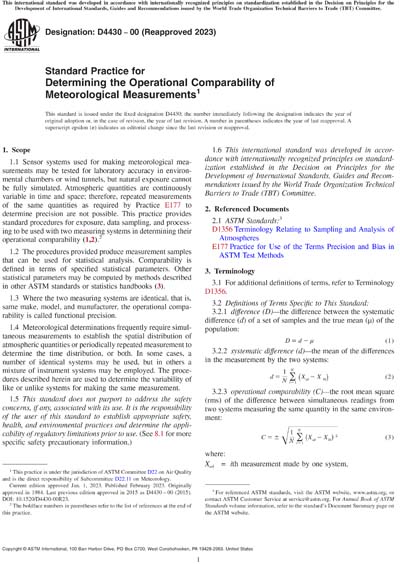Most recent
ASTM D4430-00(2023)
Standard Practice for Determining the Operational Comparability of Meteorological Measurements
1.1Sensor systems used for making meteorological measurements may be tested for laboratory accuracy in environmental chambers or wind tunnels, but natural exposure cannot be fully simulated. Atmospheric quantities are continuously variable in time and space; therefore, repeated measurements of the same quantities as required by Practice E177 to determine precision are not possible. This practice provides standard procedures for exposure, data sampling, and processing to be used with two measuring systems in determining their operational comparability (1,2).2
1.2The procedures provided produce measurement samples that can be used for statistical analysis. Comparability is defined in terms of specified statistical parameters. Other statistical parameters may be computed by methods described in other ASTM standards or statistics handbooks (3).
1.3Where the two measuring systems are identical, that is, same make, model, and manufacturer, the operational comparability is called functional precision.
1.4Meteorological determinations frequently require simultaneous measurements to establish the spatial distribution of atmospheric quantities or periodically repeated measurement to determine the time distribution, or both. In some cases, a number of identical systems may be used, but in others a mixture of instrument systems may be employed. The procedures described herein are used to determine the variability of like or unlike systems for making the same measurement.
1.5This standard does not purport to address the safety concerns, if any, associated with its use. It is the responsibility of the user of this standard to establish appropriate safety, health, and environmental practices and determine the applicability of regulatory limitations prior to use. (See 8.1 for more specific safety precautionary information.)
1.6This international standard was developed in accordance with internationally recognized principles on standardization established in the Decision on Principles for the Development of International Standards, Guides and Recommendations issued by the World Trade Organization Technical Barriers to Trade (TBT) Committee.
Content Provider
ASTM International [astm]






